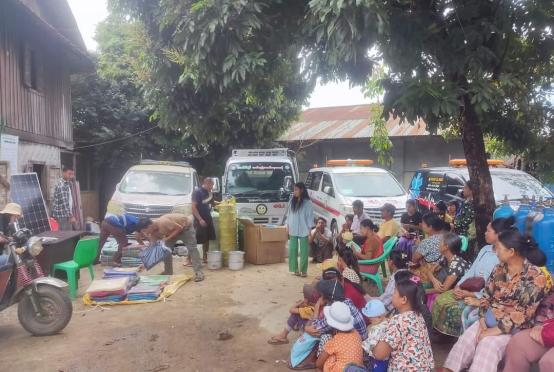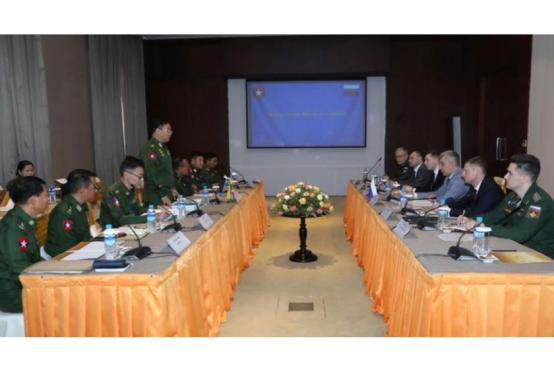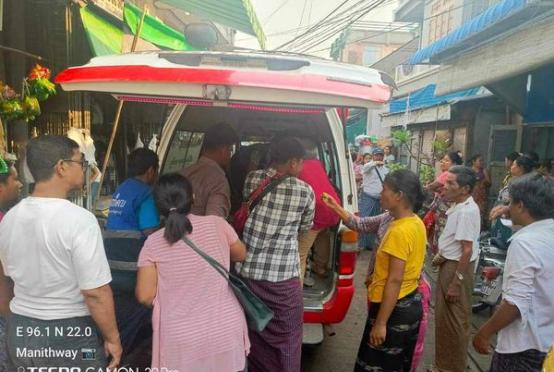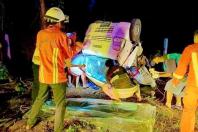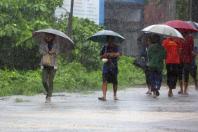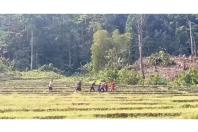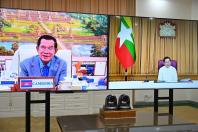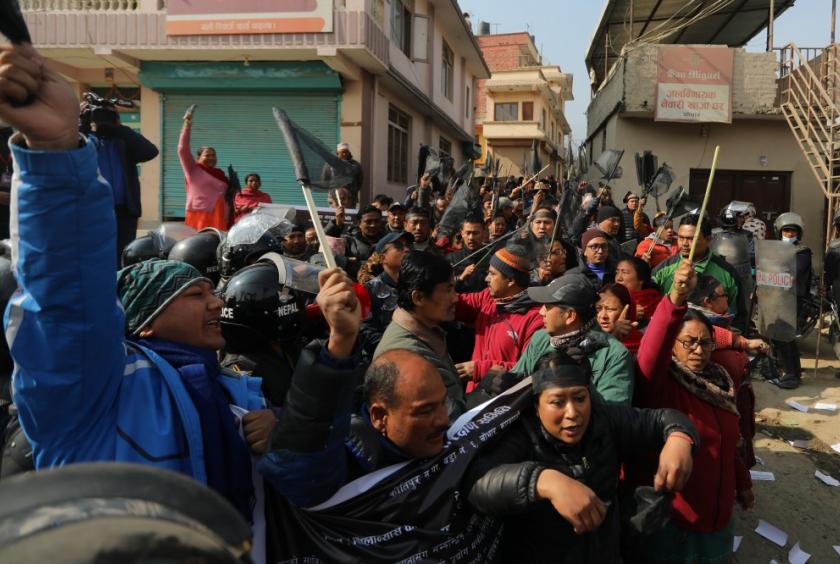
Kathmandu (The Kathmandu Post) - A group of residents from Chobhar had gathered at the Kirtipur mayor’s office on January 20 to submit a memorandum, requesting the local government to intervene against the construction of a dry port. Emotions ran high as the members of the Chobhar Conservation Committee detailed their reasons for their reservation and the use of force by the armed police two days earlier when Prime Minister KP Sharma Oli laid the foundation stone for the dry port at the south-western township in Kathmandu Valley.
Fifty-four protesters were arrested that day, as around 150 locals gathered with placards and chanted slogans against the plan for the dry port. But according to local residents, the armed police force had begun detaining people who were walking around the area from early in the morning. They were also forced to shutter the nearby shops, some residents said, while police set up security points on the terraces of local’s residences.
“The way we were manhandled by the armed police forces, it reminded us of the Panchayat era,” said Gyanendra Maharjan, a Chobhar native, during a meeting in the presence of town’s mayor and deputy mayor.
The mayor and his deputy, as well as the provincial assembly member of the area, were absent when the prime minister laid the foundation stone. Chobar residents said it was almost like an unofficial curfew and the presence of armed forces have still been propagating fear among them.
Bishnu Sharma Phuyal, one of the residents who was also arrested from his home in Chobhar on Friday, has been accused of sending a text message threatening the executive director of the Nepal Intermodal Transport Development Board, a government agency responsible for the construction and operation of the dry port. Phuyal is still in police custody.
Chobhar residents have three main reservations against the project. First, they want the government to address the issues regarding the land ownership and outstanding remuneration of 19 months of 415 former employees of the now-defunct Himal Cement Factory.
The land allocated for the dry port was originally set aside for the government-owned cement factory, which was shut down in 2001. Second, local elders say that the construction will destroy the cultural and historical significance of the township; and last, the environmental impact it will have on the nearby community.
“We had been in talks with the Minister of Industry, Commerce and Supplies as recently as November 20 of last year, but the government ignored our calls and forcibly started the project,” says Pancha Lal Maharjan, coordinator of the Chobhar Conservation Committee.
The government has allocated a total of 228 ropanis for the dry port. Of the 1,054 ropanis of land acquired, which originally belonged to the now-defunct cement factory, officials have proposed building an international exhibition centre in the remaining 826 ropanis of land. But according to Maharjan, the locals have been using nearly 115 ropanis of land. “We have receipts from land revenue office that prove the locals’ right over some of the property the government has annexed,” he said.
Additionally, when the cement factory shut down, its parent organisation, Nepal Industrial Development Corporation, sought to sell the land to third parties. The locals vehemently opposed the move, citing Clause 34 of the Land Acquisition Act-1977 that states: “If a government body does not utilise the acquired land for the purpose originally mentioned, then such land shall be returned to the expropriated landowner.”
On December 29, 2005, then Patan Appellate Court ruled that the District Administration Office had the right to resolve the matter. In 2006, the Supreme Court upheld the Appellate Court’s verdict. But Maharjan said that it was never resolved.
“We then wrote to the Prime Minister’s Office, after which the Cabinet instructed the District Administration Office to resolve the matter. But there’s no decision yet,” Maharjan said. “Without resolving these issues, laying the foundation for a new project indicates the government’s unwillingness to understand the community’s sentiments.
But Rabi Shankar Sainju, executive director of the development board, said the board had acquired the land through due process. “We cannot compromise on the construction of the dry port,” he said. “We are examining the locals’ claims that the government has annexed private properties, but the locals have also encroached upon the government land and it has to be returned to the board.”
Sainju added that the government agency is open to reimbursing the outstanding remuneration of the former employees of the cement factory.
In addition to these issues, some local residents say Chobhar is not an appropriate location to construct infrastructure like dry port. “How would you feel if they built something on your front porch? That is exactly what the government is planning to do by disregarding the plight of a local settlement,” said Gopal Dhital, a Chobhar native.
 Prime Minister KP Sharma Oli unveils a plaque during a programme to lay the foundation for the construction of dry port at Chobhar, Kathmandu. Post Photo: Elite Joshi
Prime Minister KP Sharma Oli unveils a plaque during a programme to lay the foundation for the construction of dry port at Chobhar, Kathmandu. Post Photo: Elite Joshi
Bijaya Krishna Shrestha, a professor of urban planning and designing at Khwopa Engineering College in Bhaktapur, agrees with the locals’ sentiments.
“There has been no study on why the dry port should be built at that township. The entry points to Kathmandu are either through Thankot or Tokha border, so investing in such huge projects on an ad-hoc basis will never have good results,” Shrestha told the Post.
Sainju, however, maintains that the Chobhar dry port will cater to the fast track road project, an expressway connecting Kathmandu to Nijgadh. “The dry port in Kathmandu will divert the pressure from the ones that are closer to the border. It will ease the supplies in the Valley,” he said.
But according to Shrestha, development projects like fast track and outer Ring Road are controversial, and can be counterproductive if the government fails to win the public trust. “To implement any development projects, especially the larger ones as a dry port, there needs to be a buffer zone between the human habitat and the industrial area,” he said. “The distance and perimeter of the buffer zone will be governed by the project’s scale.”
Shrestha said buffer zones are not just compulsory where there are settlements. In the case of Chobhar, it is necessary to ensure that the cultural and religious heritages are also preserved.

A recent view of the proposed dry port construction site at Chobhar, Kathmandu. Post Photo: Elite Joshi
Sudarshan Raj Tiwari, a historian, said that there are both Buddhist and Hindu religious and cultural significances connected to Chobhar. “The legend of the foundation of Kathmandu from a lake to a valley originates from Chobhar—after Manjushree, a divine saint from Tibet, cut a deep gorge allowing the water to drain,” he said. Additionally, there are two major temple resources—Aadinath and Jalbinayak—and their scriptures dating back to the 13th or 14th centuries.
“We are planning to construct a statue of Manjushree at Chobhar gorge and promote it as a Buddhist pilgrimage. But the construction of dry port overshadows these cultural heritages, and the port’s subsequent expansion poses a threat to the existing local settlement,” Maharjan said.
Sainju dismissed claims that the construction of a dry port will adversely affect the community, environment and cultural heritage of the area. “The dry port will not pollute the environment as much as the locals are claiming and there are no plans of expansion either,” he said.
But Shrestha disagrees. He said the local community’s fear that they will be displaced one day is a valid one and the government has to hold a dialogue with the local residents and environmental and heritage experts before kicking off a project of this magnitude. The only thing the community wants, Shrestha said, is answers to some basic questions.
“Are these kinds of development projects simply manufactured ideas based on the government’s urgency to fulfil budget requirements?” he continued, “Or are they actually in the interest of the public?”
 A recent view of the proposed dry port construction site at Chobhar, Kathmandu. Post Photo: Elite Joshi
A recent view of the proposed dry port construction site at Chobhar, Kathmandu. Post Photo: Elite Joshi
http://bit.ly/2FXZbEJ

